Understanding Why, Where, When, and How Many
Making sense of our experiences requires accurately representing not only who or what was involved in an event but also why, where, when, and how often the event occurred. To grasp the importance of these latter concepts, imagine what life would be like if you lost your understanding of any one of them—your sense of time, for example. Without a sense of time, you would not know the order in which events occurred. Did you get dressed and then eat breakfast, or did you eat breakfast and then get dressed? Your whole impression of your life as a continuous stream of events would be shattered. Similar problems would arise if you lost your sense of causality or space or number. Reality would resemble a nightmare in which order and predictability were suspended and chaos reigned.
279
As described in the previous section, the categories that children need to answer the questions “Who?” and “What?” begin forming in infancy, though the understanding deepens for many years thereafter. Development of understanding of causality, space, time, and number follows a similar path. In each case, development begins in the first year of life, but major improvements continue throughout childhood and adolescence.
Causality
The famed eighteenth-century Scottish philosopher David Hume described causality as “the cement of the universe.” His point was that causal connections unite discrete events into coherent wholes. Consistent with Hume’s view, from early in development, children rely heavily on their understanding of causal mechanisms to infer why physical and psychological events occur. When children take apart toys to find out how they work, ask how flipping a switch makes a light go on, or wonder why Mommy is upset, they are trying to understand causal connections. Because we discussed the development of understanding of psychological causes earlier in this chapter, we now focus on the development of understanding of physical causes.
Nativists and empiricists fundamentally disagree about the origins of understanding of physical causes. The difficulty of making sense of the world without some basic causal understanding and the fact that children show some such understanding early in infancy have led nativists to propose that infants possess an innate causal module or core theory that allows them to extract causal relations from the events they observe (e.g., Leslie, 1986; Spelke, 2003). Empiricists, however, have proposed that infants’ causal understanding arises from their observations of innumerable events in the environment (e.g., L. B. Cohen & Cashon, 2006; T. T. Rogers & McClelland, 2004). One fact both sides agree on is that children show impressive causal reasoning from infancy onward.
Very Early Causal Reasoning
By 6 months of age, infants perceive causal connections among some physical events (L. B. Cohen & Cashon, 2006; Leslie, 1986). In a typical experiment demonstrating infants’ ability to perceive such relations, Oakes and Cohen (1995) presented 6- to 10-month-olds a series of video clips in which a moving object collided with a stationary object and the stationary object immediately moved in the way one would expect. Different moving and stationary objects were used in each clip, but the basic “plot” remained the same. After seeing a few of these video clips, infants habituated to the collisions. Then the infants were shown a slightly different clip in which the stationary object started moving shortly before it was struck. Infants looked at this event for a longer time than they had looked during the preceding trials, presumably because the new video clip violated their sense that inanimate objects do not move on their own.
280
Infants’ and toddlers’ understandings of physical causality influence not only their expectations about inanimate objects but also their ability to remember and imitate sequences of actions. When 9- to 11-month-olds are shown actions that are causally related (e.g., making a rattle by putting a small object inside two cups that can be pushed together to form a single container), they usually can reproduce the actions (Figure 7.4 shows a toddler performing this procedure) (Carver & Bauer, 1999). In contrast, when similar but causally unrelated actions are shown, babies do not reliably reproduce them until age 20 to 22 months (Bauer, 2007).

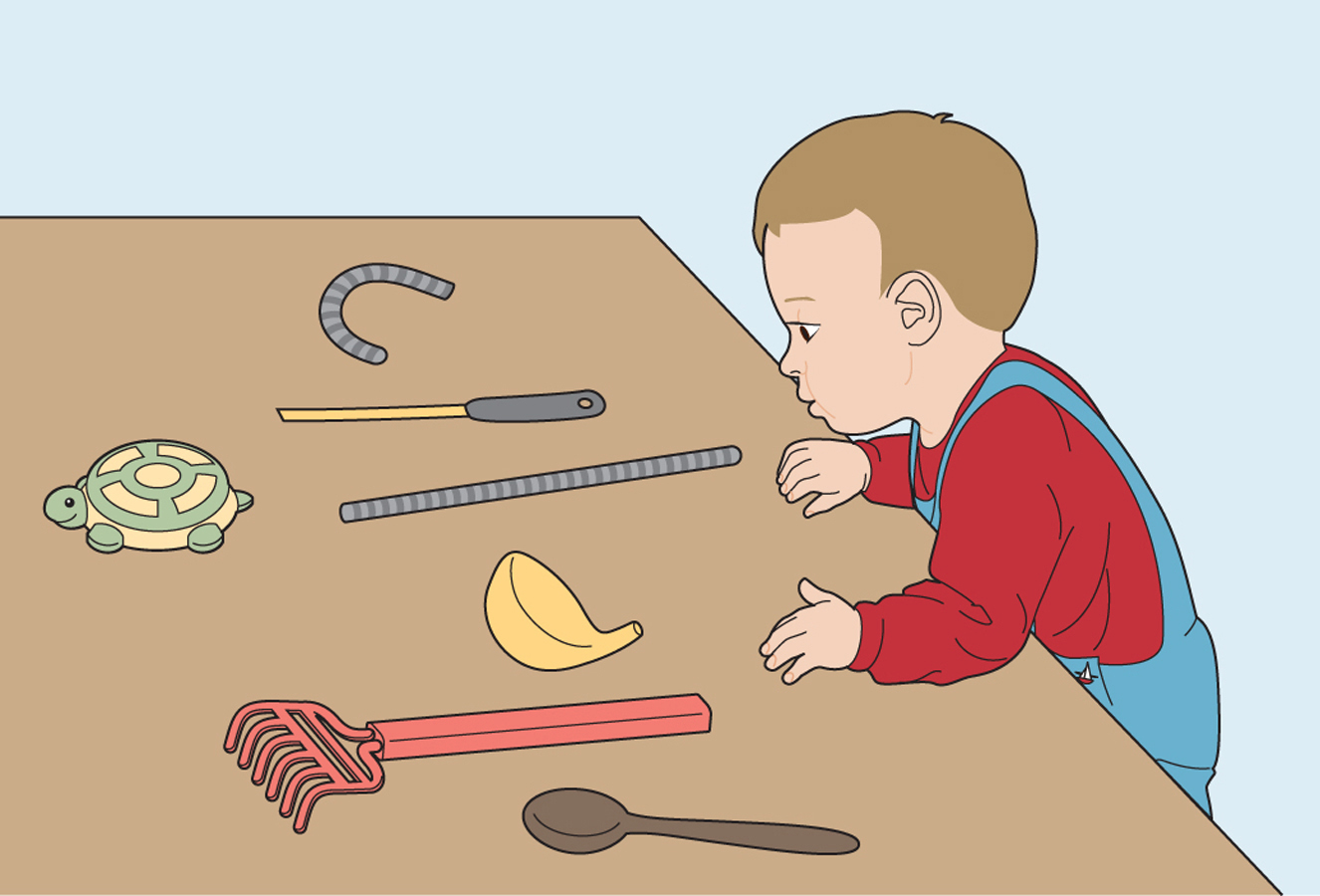
By the end of their second year, and by some measures even earlier, children can infer the causal impact of one variable based on indirectly relevant information about another. Sobel and Kirkham (2006), for instance, presented 19- and 24-month-olds a box called a “blicket detector” that, the experimenter explained, played music when a type of object called a blicket was placed on it. Then the experimenter placed two objects, A and B, on the blicket detector, and the music played. When the experimenter then placed object A alone on the blicket detector, the music did not play. Finally, the children were asked to turn on the blicket detector. The 24-month-olds consistently chose object B, indicating that seeing the ineffectiveness of object A led them to infer that object B was the blicket. In contrast, the 19-month-olds chose object A as often as they did object B, suggesting that they did not draw this inference.
Another illustration of this growing understanding of causality comes from Z. Chen and Siegler’s (2000) study of 1- and 2-year-olds’ tool use. The toddlers were presented an attractive toy that was sitting on a table roughly a foot beyond their reach. Between the child and the toy were six potential tools that varied in length and in the type of head at the end of the shaft (Figure 7.5). To succeed on the task, the toddlers needed to understand the causal relations that would make one tool more effective than the others for pulling in the toy. In particular, they needed to understand that a sufficiently long shaft and a head at right angles to the shaft were essential.
281
The 2-year-olds succeeded considerably more often than the 1-year-olds did in obtaining the toy, both in their initial efforts to get it on their own and after being shown by the experimenter how they could use the optimal tool to obtain it. One reason for the older toddlers’ greater success was that they more often used a tool to try to get the toy, as opposed to reaching for it with their hands or seeking their mother’s help. Another reason was that the older toddlers chose the optimal tool in a greater percentage of trials in which they used some tool. A third reason was that the older toddlers more often generalized what they had learned on the first problem to new, superficially different problems involving tools and toys with different shapes, colors, and decorations. All these findings indicate that the older toddlers had a deeper understanding of the causal relations between a tool’s features and its usefulness for pulling in the toy.
Causal Reasoning During the Preschool Period
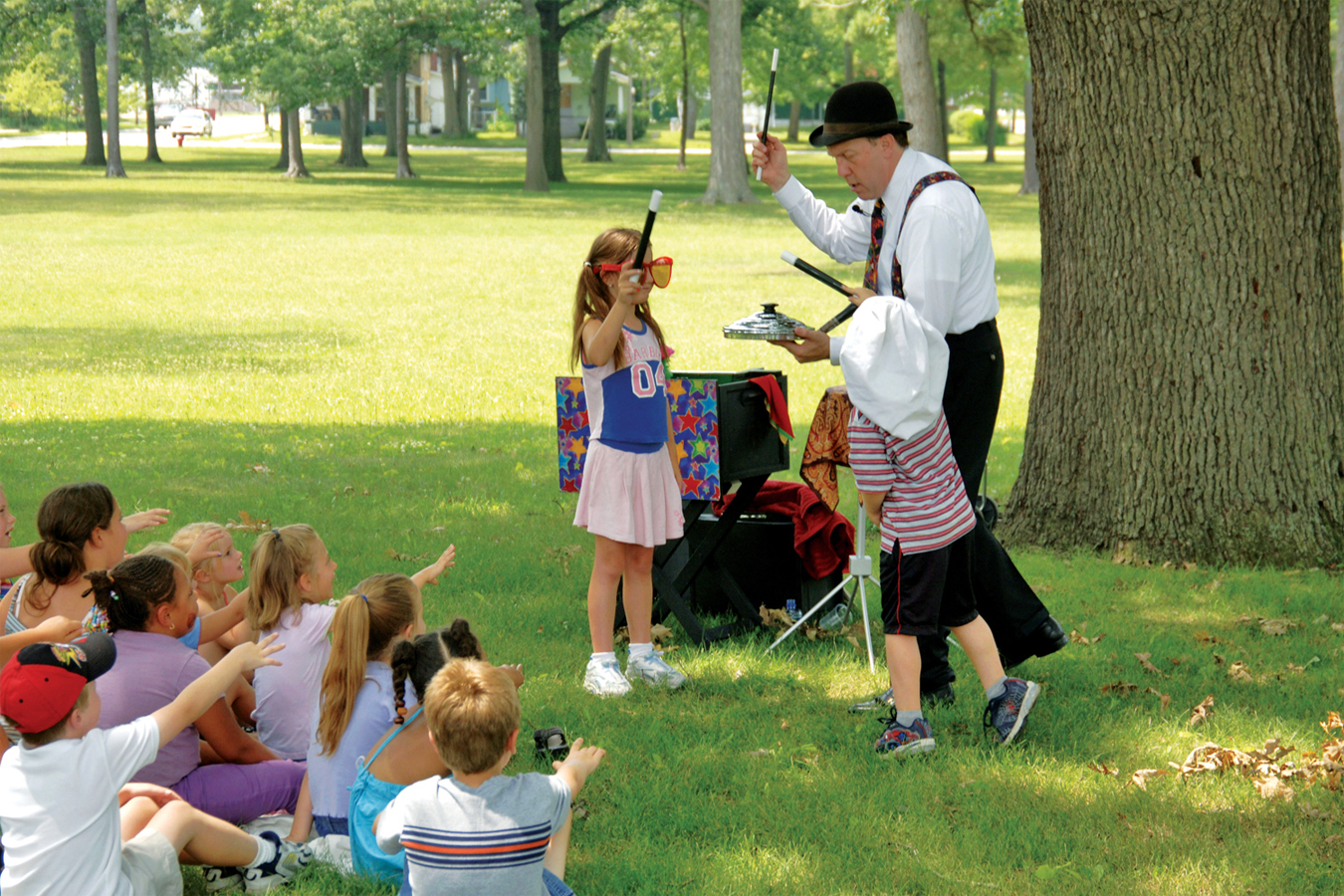
Causal reasoning continues to grow in the preschool period. Preschoolers seem to expect that if a variable causes an effect, it should do so consistently (Schulz & Sommerville, 2006). When 4-year-olds see a potential cause produce an effect inconsistently, they infer that some variable that they cannot see must cause the effect; when the same effect occurs consistently, they do not infer that a hidden variable was important. For example, if 4-year-olds saw some dogs respond to petting by eagerly wagging their tails and other dogs respond to petting by growling, they might infer that some variable other than the petting, such as the dogs’ breed, caused the effect. But if all the dogs they had ever seen looked happy when petted, they would not infer that the dogs’ breed was relevant.
Preschoolers’ emerging understanding that events must have causes also seems to influence their reactions to magic tricks. Most 3- and 4-year-olds fail to see the point of such tricks; they grasp that something strange has happened but do not find the “magic” humorous or actively try to figure out what caused the strange outcome (Rosengren & Hickling, 2000). By age 5, however, children become fascinated with magic tricks precisely because no obvious causal mechanism could produce the effect (Box 7.3). Many want to search the magician’s hat or other apparatus to see how such a stunt was possible. This increasing appreciation that even astonishing events must have causes, along with an increasing understanding of the mechanisms that connect causes and their effects, reflect the growth of causal reasoning.
282
Box 7.3: a closer look: MAGICAL THINKING AND FANTASY
Lest you conclude that by age 5, children’s causal reasoning is as advanced as that of adults, consider the following conversation between two kindergartners and their teacher:
- Lisa: Do plants wish for baby plants?
- Deana: I think only people can make wishes. But God could put a wish inside a plant….
- Teacher: I always think of people as having ideas.
- Deana: It’s just the same. God puts a little idea in the plant to tell it what to be.
- Lisa: My mother wished for me and I came when it was my birthday.
(Paley, 1981, pp. 79–80)
This is not a conversation that would have occurred between 10-year-olds and their teacher. Rather, as noted by Jacqui Woolley, a psychologist who studies preschoolers’ fantasies, it reflects one of the most charming aspects of early childhood: preschoolers and young elementary school children “live in a world in which fantasy and reality are more intertwined than they are for adults” (Woolley, 1997).
Young children’s belief in fantasy and magic, as well as in normal causes, is evident in many ways. Most 4- to 6-year-olds believe that they can influence other people by wishing them into doing something, such as buying a particular present for their birthday (Vikan & Clausen, 1993). They believe that effective wishing takes a great deal of skill, and perhaps magic, but that it can be done. In related fashion, many believe that getting in good with Santa Claus can make their hopes come true. The fantasies can have a dark side as well, such as when children fear that monsters might hurt them (Woolley, 1997).
Research has shown that young children not only believe in magic; they sometimes also act on their belief. In one experiment, preschoolers were told that a certain box was magical and that if they placed a drawing into it and said magical words, the object depicted in the drawing would appear. Then the experimenter left the children alone with the box and a number of drawings. The children put drawings of the most attractive items into the box, said the “magical words,” and were visibly disappointed when they opened the box and found only the drawings (Subbotsky, 1993, 1994).
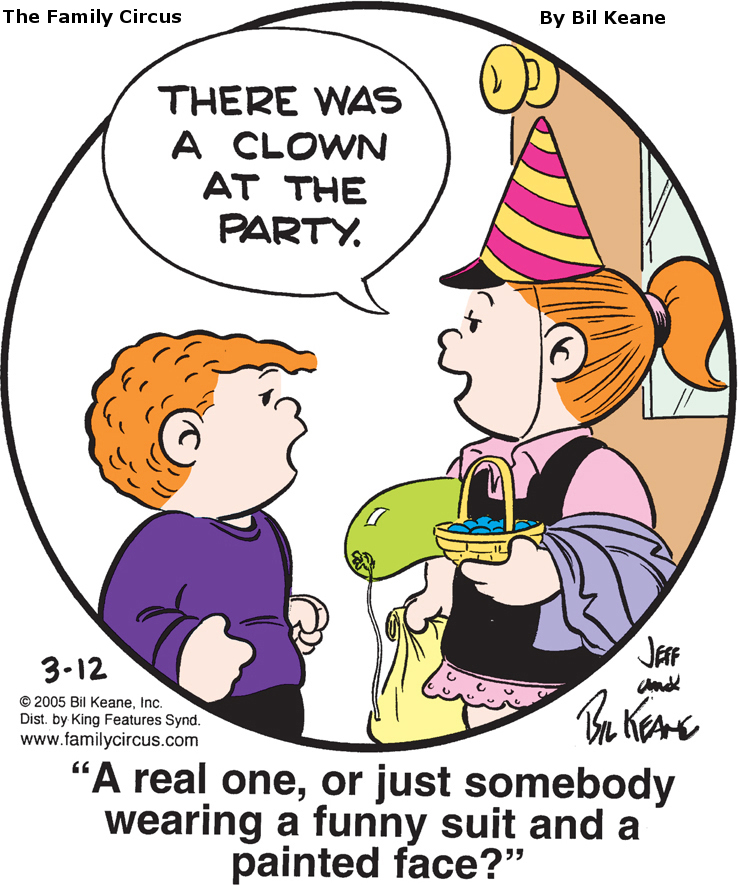
How can we reconcile preschoolers’ understanding of physical causes and effects with their belief in magic, wishing, and Santa Claus? The key is to recognize that here, as in many situations, children simultaneously believe a variety of somewhat contradictory ideas. They may think that magic or the power of their imagination can cause things to happen, but they may not depend on it when doing so could be embarrassing. In one demonstration of this limited belief in magic and the power of the imagination (Woolley & Phelps, 1994), an experimenter showed preschoolers an empty box, closed it, and then asked them to imagine a pencil inside it. The experimenter next asked the children whether there was now a pencil in the box. Many said “yes.” Then an adult came into the room and said that she needed a pencil to do her work. Very few of the preschoolers opened the box or handed it to her. Thus, it appeared that many children said the box contained a pencil when no consequences would follow if they were wrong, but they did not believe in magic strongly enough to act in a way that might look foolish to an adult.
How do children move beyond their belief in magic? One means is learning more about real causes: the more children know about the true causes of events, the less likely they are to explain them in magical terms (Woolley, 1997). Another influence is personal experiences that undermine the child’s magical beliefs, such as hearing peers pooh-pooh the idea of Santa Claus or seeing two Santa Clauses on the same street. Sometimes, however, children salvage their hopes by distinguishing between flawed manifestations of the magical being and the magical being itself. They may, for example, fervently distinguish between the real Santa Claus and imposters who dress up to look like him.
Although this world of the imagination is most striking between ages 3 and 6, aspects of it remain evident for years thereafter. In one study that demonstrated the persistence of magical thinking, many 9-year-olds and some adults reverted to magical explanations when confronted with a trick that was difficult to explain in physical terms (Subbotsky, 2005). Moreover, in a recent poll of a representative sample of the American population, 31% of adults said that they believe in ghosts (Rasmussen, 2011). These beliefs in the supernatural cannot be written off as simply reflecting a lack of education. Subbotsky (2005) found that 0 of 17 college-student participants were willing to allow someone who was said to be a witch to cast an evil spell on their lives. Innumerable other adults indulge superstitions such as not walking under ladders, avoiding cracks in sidewalks, and knocking on wood. Apparently, we never entirely outgrow magical thinking.
283
Space
The nativist/empiricist debate has been vigorous with regard to spatial thinking. Nativists argue that children possess an innate module that is specialized for representing and learning about space and that processes spatial information separately from other types of information (Hermer & Spelke, 1996; Hespos & Spelke, 2004). Empiricists argue that children acquire spatial representations through the same types of learning mechanisms and experiences that produce cognitive growth in general, that children adaptively combine spatial and nonspatial information to reach their goals, and that language and other cultural tools such as puzzles shape spatial development (Gentner & Boroditsky, 2001; S. C. Levine et al., 2012; Newcombe & Huttenlocher, 2006).
Nativists and empiricists agree on some issues. One is that from early in infancy, children show impressive understanding of some spatial concepts, such as above, below, left of, and right of (Casasola, 2008; P. C. Quinn, 2005). Another common conclusion is that self-produced movement around the environment stimulates processing of spatial information. A third shared belief is that certain parts of the brain are specialized for coding particular types of spatial information; for example, development of the hippocampus appears to produce improvements in place learning (Sluzenski, Newcombe, & Satlow, 2004; Sutton, Joanisse, & Newcombe, 2010). A fourth common conclusion is that geometric information—information about lengths, angles, and directions—is extremely important in spatial processing. When toddlers and preschoolers are given clues to an object’s location, they often weigh such geometric information more strongly than seemingly simpler nongeometric cues, such as the object’s being in front of the one blue wall in the room (Hermer & Spelke, 1996; Newcombe & Ratliff, 2007).
Effective spatial thinking requires coding space relative to oneself and relative to the external environment. Next we consider each of these types of spatial coding.
Representing Space Relative to Oneself
From early in infancy, children code the locations of objects in relation to their own bodies. As noted in Chapter 5, when young infants are presented with two objects, they tend to reach for the closer one (van Wermeskerken et al., 2012). This shows that they recognize which object is closer and that they know the direction of that object relative to themselves.
Over the ensuing months, infants’ representations of spatial locations become increasingly durable, enabling them to find objects they observed being hidden some seconds earlier. As discussed in Chapter 4, most 7-month-olds reach to the correct location for objects that were hidden 2 seconds earlier under one of two identical opaque covers, but not for objects hidden 4 seconds earlier, whereas most 12-month-olds accurately reach for objects hidden 10 seconds earlier (A. Diamond, 1985). In part, these increasingly enduring object representations reflect brain maturation, particularly of the dorsolateral prefrontal cortex, an area in the frontal lobe that is involved in the formation and maintenance of plans and in the integration of new and previously learned information (A. Diamond & Goldman-Rakic, 1989; J. K. Nelson, 2005). However, the improved object representations reflect learning as well: infants who are provided a learning experience with a hidden object in one situation show improved location of hidden objects in other situations (S. P. Johnson, Amso, & Slemmer, 2003).
284
egocentric spatial representations coding of spatial locations relative to one’s own body, without regard to the surroundings
Note that the preceding examples of infants’ ability to code space involve infants remaining in a single location and coding locations relative to their bodies. Piaget (1954/1971) proposed that this is the one kind of spatial coding that infants can do. The reason, according to his theory, is that during the sensorimotor period, infants can form only egocentric spatial representations, in which the locations of objects are coded relative to the infants’ position at the time of the coding. As evidence, Piaget reported experiments showing that if infants repeatedly found a toy located to their right, they would continue to turn right to find it, even if they were repositioned so that the object was now on their left. Subsequent investigators replicated this finding (e.g., L. P. Acredolo, 1978; Bremner, 1978).
Egocentric spatial representation during infancy is not absolute, however. If toys are hidden adjacent to a distinctive landmark, such as a tower, infants usually find the toy despite changes in their own position (Lew, 2011). Still, the question remains: How do young children become able to find objects when their own position has changed and when no landmarks are available to guide their search?
A major factor in helping infants acquire a sense of space independent of their own location appears to be self-locomotion. Infants who crawl or have had experience propelling themselves in walkers more often remember the locations of objects on the object permanence task (page 165) than do infants of the same age without such locomotor experience (Bertenthal, Campos, & Kermoian, 1994; Campos et al., 2000). Similarly, compared with infants who have not yet moved across rooms on their own, those infants who have done so show an earlier understanding of depth and drop-offs on the surfaces they travel; this is evidenced by acceleration in their heart rate as they approach the visual cliff in the procedure described on page 196.
The reasons why self-locomotion enhances infants’ representation of space should be familiar to anyone who has both driven a car and been a passenger in one. Just as driving requires continuous updating of information about the surroundings, so does crawling or walking. In contrast, just as being a passenger in a car does not require such continuous updating of one’s location, neither does being carried.
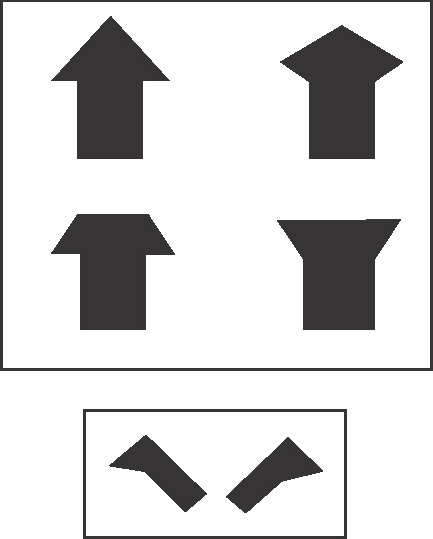
As would be expected from this analysis, self-locomotion also enhances older children’s spatial coding. Striking evidence for this conclusion emerged from a study in which kindergarteners were tested in the kitchens of their own homes (Rieser, Garing, & Young, 1994). Some kindergartners were asked to stand in place, imagine themselves walking from their seat in the classroom to the teacher’s chair, and turning around to face the class. Then they were asked to point from this imagined position in the classroom to the locations of various objects within it—the fishbowl, the alphabet chart, the coatroom door, and so on. Under these conditions, the 5-year-olds’ pointing was inaccurate. Other kindergartners went through the same procedure, except that they were instructed to actually walk through their kitchen and turn around as they imagined themselves walking to the teacher’s chair and then turning to face the class. Under these conditions, the children’s pointing to the imagined objects in their imagined classroom was far more accurate. This result, like those described above with infants, highlights the interconnectedness of the system that produces self-generated motion and the system that produces mental representations of space (Adolph & Berger, 2006).
Another type of experience that contributes to spatial development beyond infancy is the assembling of puzzles. Children who played with puzzles more often between their 1st and 4th birthdays than their peers did were found to be more successful as 4½-year-olds on the spatial transformation task shown in Figure 7.6 (Levine et al., 2012). The relation between puzzle play and subsequent spatial reasoning occurred irrespective of parents’ education, income, and use of spatial terms while interacting with their children. This relation between puzzle play and spatial reasoning makes sense. Assembling puzzles requires identifying appropriate pieces for specific locations and physically rotating them into the proper orientation; mentally rotating pieces to identify plausible candidates for filling empty locations allows more efficient puzzle solving than would otherwise be possible. Such practice in mental rotation seems likely to build spatial-reasoning skills that can be used in future situations.
285
Development of Spatial Concepts in Blind and Visually Impaired People
People often equate spatial thinking with vision, assuming that we can think spatially only about layouts that we have seen. Even in infancy, however, spatial thought can be based on senses other than vision. Thus, when 3-month-olds are brought into a totally dark room in which nothing can be seen, they use sounds emitted by nearby objects to identify the objects’ spatial locations and reach for them (Keen & Berthier, 2004).
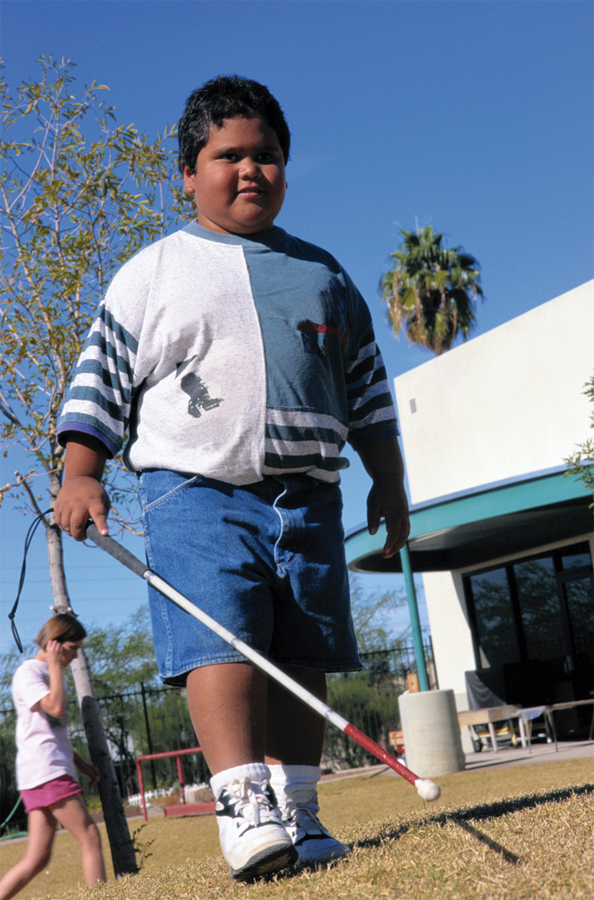
Although infants can use their auditory sense, among other senses, to form spatial representations, visual experience during infancy does play an important role in spatial development. Evidence for this conclusion comes from cases in which surgery restored sight to people who were born either blind (S. Carlson, Hyvärinen, & Raninen, 1986) or with severely impaired vision due to cataracts that prevented patterned stimulation from reaching the retina (Le Grand et al., 2001, 2003). The surgery was performed early—on average at 4 months of age—and those who underwent it subsequently had between 9 and 21 years of postsurgical visual experience before being tested. Despite their extensive visual experience after the corrective surgery, most of these people could not use visual information to represent space as well as other people can; problems remained, especially with representations of faces, even 20 years after the surgery (and thus after 20 years of visual experience). The lack of visual experience in the few months of infancy limited subsequent visual development.
These findings do not mean that children who are born blind cannot represent space. They actually tend to have a surprisingly good spatial sense. On tasks involving the representation of very small spaces, such as being guided in drawing two sides of a triangle on a piece of paper and then being asked to complete the triangle by drawing the third side themselves, children who are born blind perform as well as sighted children who are blindfolded (Thinus-Blanc & Gaunet, 1997). On tasks involving representation of large spaces, such as those formed by exploring unfamiliar rooms, the spatial representations of people born blind also are surprisingly good, about as good as those formed by sighted people who were blindfolded during the exploration period. Thus, although some spatial skills seem to require early visual experience, many blind people develop impressive senses of space without ever seeing the world.
Representing Space Relative to the External Environment
As we have noted, infants as young as 6 months can use landmarks to code the location of objects they observe being hidden (Lew, 2011). However, for such young infants to use a landmark successfully, it must be the only obvious landmark in the environment and must be located right next to the hidden object.
With development, infants become increasingly able to choose among alternative potential landmarks. When 12-month-olds are presented a single yellow cushion, a single green cushion, and a large number of blue cushions, they have little trouble finding an object hidden under either the yellow or the green cushion (Bushnell et al., 1995). At 22 months, but not at 16 months, the presence of a landmark improves children’s ability to locate an object that is not hidden adjacent to the landmark (Newcombe et al., 1998). By age 5 years, children can also represent an object’s position in relation to multiple landmarks, such as when it is midway between a tree and a street lamp (Newcombe & Huttenlocher, 2006).
286
Children, like adults, have more difficulty forming a spatial representation when they are moving around in an environment without distinctive landmarks or when the only landmarks are far from the target location. To understand the challenge of such tasks, imagine walking in an a forest without cleared paths and not being able to remember exactly how you arrived at your current location. How easily could you find your way back to your starting point?
Even toddlers show the required navigational ability to some degree—good enough to lead them in the right general direction (Loomis et al., 1993). In one experiment, 1- and 2-year-olds first saw a small toy hidden in a long, rectangular sandbox and then saw a curtain descend around the sandbox, thus hiding the toy. The toddlers then walked to a different location, after which they were asked to find the toy. Despite no landmarks being present, the toddlers kept track of the hidden toy’s location well enough to show better than chance accuracy in their searches (Newcombe et al., 1998).
However, forming relatively precise coding of locations in the absence of straightforward landmarks continues to be difficult for people well beyond 2 years of age (Bremner, Knowles, & Andreasen, 1994). Six- and seven-year-olds are not very good at it (Overman et al., 1996), and adults vary tremendously in their abilities to perform this type of navigation. For example, when adults are asked to walk around the perimeter of an unfamiliar college campus and then to walk straight back to the starting point, some are quite accurate, but many choose routes that take them nowhere near the original location (Cornell et al., 1996).

The degree to which people develop spatial skills is strongly influenced by the importance of such skills in their culture. To demonstrate this point, Kearins (1981) compared the spatial abilities of seminomadic aboriginal children growing up in the Australian desert with those of White peers growing up in Australian cities. Spatial ability is essential within aboriginal culture, because much of life within this culture consists of long treks between distant water holes. Needless to say, the aboriginal people cannot rely on road signs; they must rely on their sense of space to get to the water. Consistent with the importance of spatial skills within their everyday lives, aboriginal children are superior to their city-dwelling peers in memory for spatial location, even in board games, a context that is more familiar to the urban children (Kearins, 1981). Thus, consistent with the general importance of the sociocultural context, how people make use of spatial thinking in their everyday activities greatly influences their quality of spatial thinking.
Time
“What then is time? I know well enough what it is, provided nobody asks me; but if I am asked and try to explain, I am baffled.”
—Saint Augustine, 398 C.E. (1963)
287
As this quotation suggests, even the deepest thinkers, from Saint Augustine who wrote in the fourth century to Albert Einstein who wrote in the twentieth, have been mystified by the nature of time. Yet even infants in their first half-year have a rudimentary sense of time, including perception of both the order and the duration of events (W. J. Friedman, 2008).
Experiencing Time
Probably the most basic sense of time involves knowledge of temporal order, that is, knowing what happened first, what happened next, and so on. Not surprisingly, given how mystifying life would be without such a basic sense of time, infants represent an understanding of the order in which events occur from as early as the capability can be effectively measured. In one study, 3-month-olds were presented a series of interesting photos, first on their left, then on their right, then on their left, and so on. Within 20 seconds, they began to look to the side where each new photo was to appear even before the photo was presented (Adler et al., 2008; Haith, Wentworth, & Canfield, 1993). This looking pattern indicated that 3-month-olds detected the repetitive sequence of events over time and used the information to form expectations of where the next photo would appear. The same conclusion has arisen using other experimental methods; for example, 4-month-olds who were habituated to three objects falling in a constant order dishabituated when the order changed (Lewkowicz, 2004).
Infants also have an approximate sense of the durations of events. In one study, 4-month-olds saw periods of light and darkness alternate every 5 seconds for eight cycles, at which point the pattern was broken by the light’s failing to appear. Within half a second of the break, infants’ heart rates decelerated, a change that is characteristic of increased attention. In this case, the heart-rate deceleration suggested that the infants had a rough sense of the 5-second interval, expected the light to go on at the end of the interval, and increased their attention when it did not appear (Colombo & Richman, 2002).
Infants also can discriminate between longer and shorter durations. The ratio of the durations, rather than differences in their absolute length, is critical for these discriminations (Brannon, Suanda, & Libertus, 2007). For instance, 6-month-olds discriminate between two durations when their ratio is 2:1 (1 second versus 0.5 seconds or 3 seconds versus 1.5 seconds), but not when the ratio is 1.5:1 (1.5 seconds versus 1 second or 4.5 seconds versus 3 seconds). Over the course of the first year, the precision of these discriminations increases. Thus, 10-month-olds, unlike 6-month-olds, discriminate when the ratio of the durations is 1.5:1 (though not when it is 1.33:1).
What about longer periods—periods of weeks, months, or years? It is unknown whether infants have a sense of such long periods, but preschoolers do possess some knowledge regarding them. For example, when asked which of two past events occurred more recently, most 4-year-olds knew that a specific event that happened a week before the experiment (Valentine’s Day) happened more recently than an event that happened 7 weeks earlier (Christmas) (W. J. Friedman, 1991). However, preschoolers correctly answer such questions only when the more recent event is quite close in time and much closer than the less recent one. Ability to distinguish more precisely among the timing of past events develops slowly during middle childhood (W. J. Friedman, 2003). For example, when children who had been presented a distinctive classroom experience were asked 3 months later to recall the month in which the experience occurred, the percentage of correct recall increased from 20% among 5-year-olds to 46% among 7-year-olds to 64% among 9-year-olds (W. J. Friedman & Lyon, 2005).
288
Understanding of the timing of future events also increases during this age range (W. J. Friedman, 2000, 2003). Preschoolers often confuse past and future. For example, 5-year-olds predict a week after Valentine’s Day that the next Valentine’s Day will come sooner than the next Halloween or Christmas; they also predict that their next lunch is the same amount of time in the future regardless of whether they are tested just before lunch or just after it. Six-year-olds, in contrast, generally predict correctly in both cases. The improvement in children’s sense of future time between the ages of 5 and 6 years is probably influenced by 5- and 6-year-olds’ experience in kindergarten classrooms, where the cycle of seasons, holidays, and daily routines is emphasized.
Children, like adults, are subject to certain illusions about time, in part because of the role attention plays in time perception. When 8-year-olds’ attention is focused on the passage of time (for example, when they expect a prize at the end of a 2-minute interval), they perceive the duration as longer than the same interval when they are not anticipating a prize. Conversely, when they have little to do they perceive the duration as longer than when they are very busy (Zakay, 1992, 1993). Thus, the saying “A watched pot never boils” has psychological merit.
Reasoning About Time
During middle childhood, children become increasingly proficient at reasoning about time. In particular, they become able to infer that if two events started at the same time, but one event ended later than the other, then the event that ended later lasted longer.
Children as young as 5 years can sometimes make such logical inferences about time, but only in simple, straightforward situations. For instance, when told that two dolls fell asleep at the same time and that one doll awoke before the other, 5-year-olds reason correctly that the doll that awoke later also slept longer (Levin, 1982). However, when 5-year-olds see two toy trains travel in the same direction on parallel tracks, and one train stops farther down the track, they usually say that the train that stopped farther down the track traveled for a longer time, regardless of when the trains started and stopped moving (C. Acredolo & Schmid, 1981). The problem is that the 5-year-olds’ attention is captured by the one train being farther down the track, which leads them to focus on the spatial positions of the trains rather than on their relative starting and stopping times. If this observation reminds you of Piaget’s idea of centration (pages 139–141), there is good reason: Piaget’s (1969) observations of performance on this task were part of what led him to conclude that children in the preoperational stage often center on a single dimension and ignore other, more relevant ones.
Number
Like causality, space, and time, number is a central dimension of human experience. It is hard to imagine how the world would appear if we did not have at least a crude sense of number—we would not know how many fingers or family members we have, for example. Unsurprisingly, the nativist/empiricist debate has extended to the concept of number. Nativists argue that children are born with a core concept of number that includes special mechanisms for representing and learning about the relative numbers of objects in sets, counting, and simple addition and subtraction (Wynn, 2000). As evidence, they note that specific brain areas, particularly the intraparietal sulcus, are heavily involved in representing numerical magnitudes (Ansari, 2008; Nieder & Dehaene, 2009) and that specific neurons respond most strongly when particular numbers of objects (e.g., 5 objects) are displayed (Nieder, 2012). In contrast, empiricists argue that children learn about numbers through the same types of experiences and learning mechanisms that help them acquire other concepts and that infants’ numerical competence is not as great as nativists claim (Clearfield, 2006; Mix, Huttenlocher, & Levine, 2002). They also note the existence of large differences in numerical understanding among children of different cultures and document the contributions of instruction, language, and cultural values to these differences (Geary, 2006; K. F. Miller et al., 1995). In this section, we review current evidence regarding numerical development as well as nativist and empiricist perspectives on the evidence.
289
Numerical Equality
numerical equality the realization that all sets of N objects have something in common
Perhaps the most basic understanding of numbers involves numerical equality, the idea that all sets of N objects have something in common. When children recognize, for example, that two dogs, two cups, two balls, and two shoes share the property of “twoness,” they have a rudimentary understanding of numerical equality.
Infants as young as 5 months old appear to have some sense of numerical equality, at least as it applies to sets of one, two, or three objects. The evidence for this conclusion comes from studies using the familiar habituation paradigm. In these studies, young infants are shown a sequence of pictures, with each picture having the same number of objects but differing in other ways. For example, infants might be shown three stars arranged vertically, then three circles arranged horizontally, then three diamonds arranged diagonally, and so on. After the infants habituate to the pictures of three objects, they are shown a picture with a different number of objects (such as two squares). These studies indicate that 5-month-olds show renewed interest when the number of objects changes (van Loosbroek & Smitsman, 1990).
This tendency is weak—infants’ discriminations are often based on the objects’ relative area or perimeter rather than on their number, when both vary (Clearfield & Mix, 1999; Feigenson, Carey, & Spelke, 2002). However, infants also discriminate among small numbers of events, which do not have perimeters or areas, indicating that they have a sense of number independent of spatial concepts. In one demonstration of this numerical understanding, Wynn (1995) showed 6-month-olds a puppet that repeatedly jumped twice. After the infants habituated to this pattern, they were shown the puppet jumping either once or three times. The infants’ looking time increased when the number of jumps changed, suggesting that they discriminated between two jumps and one or three.
As with discriminations among temporal durations, infants’ discriminations between numerical sets depend in large part on the ratio of the number of entities in them. For example, as with temporal durations, 6-month-olds discriminate between sets with 2:1 ratios (e.g., 16 versus 8 dots or sounds) but not between sets with ratios of 1.5:1 (e.g., 12 versus 8 dots or sounds) (Brannon, 2002; Lipton & Spelke, 2003). Also similar to discriminations between temporal durations, numerical-set discriminations become more precise with age: 6-month-olds do not discriminate between ratios of 1.5:1 objects, but 9-month-olds do (J. N. Wood & Spelke, 2005). However, the absolute number of objects also matters: on some tasks, 9- and 11-month-old infants discriminate between one and two objects but not between two and four or three and six objects (Feigenson, Carey, & Hauser, 2002).
290
Infants’ Arithmetic
Some experts on early understanding of number have concluded that infants also have a basic understanding of arithmetic (R. Gelman & Williams, 1998; Wynn, 1992). The type of evidence on which they base their conclusion is illustrated in Figure 7.7. A 5-month-old sees a doll on a stage. A screen comes up, hiding the doll from the infant’s sight. Next, the infant sees a hand place a second doll behind the screen and then sees the hand emerge from behind the screen without the doll, thus seeming to have left the second doll with the first one. Finally, the screen drops down, revealing either one or two dolls. Most 5-month-olds look longer when there is only one doll, suggesting that they expected that 1 + 1 should equal 2 and that they were surprised when they saw only a single object. Similar results are seen with subtraction: 5-month-olds look longer when the apparent removal of one of two objects results in two objects being present than when the removal results in one object being there (Wynn, 1992).
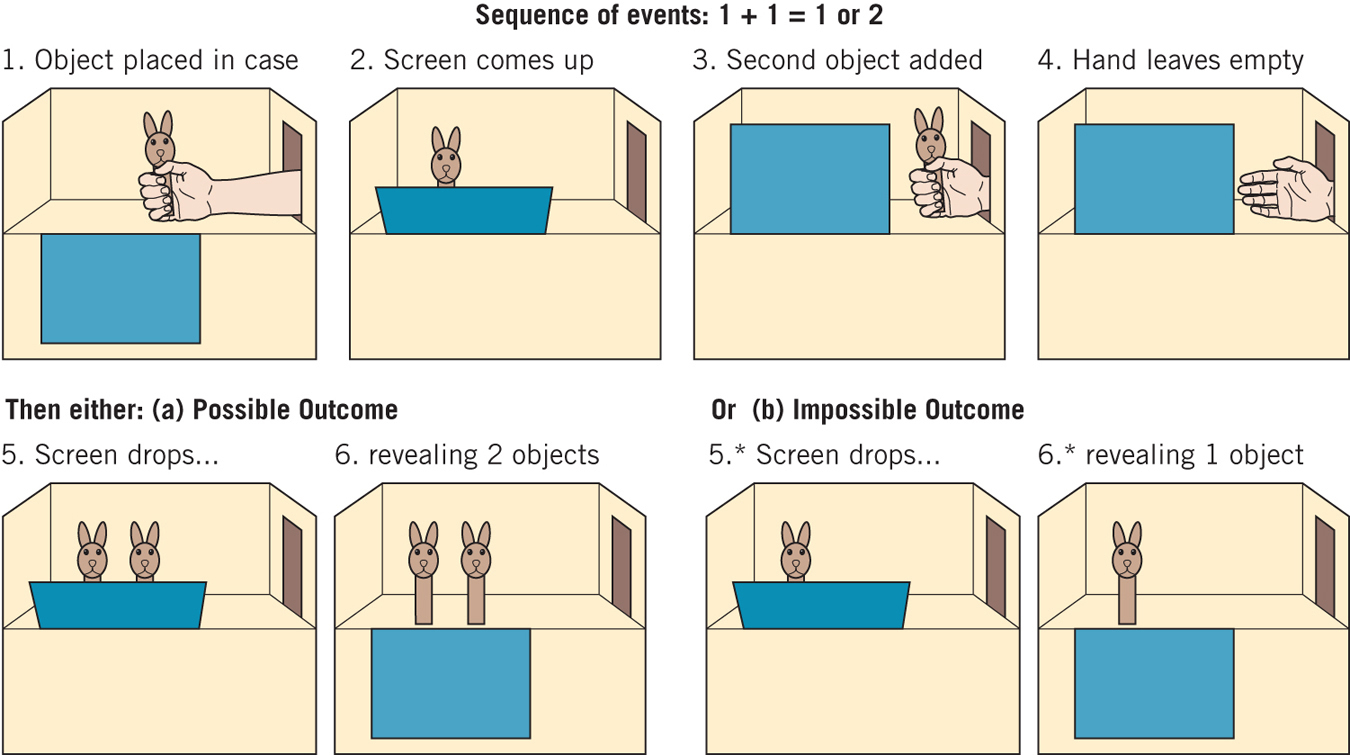
But do these findings show that infants understand arithmetic? The claim that they do has evoked a great deal of argument. One reason for the controversy is that efforts to replicate the original result have had mixed success. Some studies have replicated it (T. J. Simon, Hespos, & Rochat, 1995), others have not (Wakeley, Rivera, & Langer, 2000). A more general reason for the controversy is that infants show the precise understanding required by arithmetic only in situations in which the total number of objects is three or fewer. Children do not show similar, precise understanding of the effects of adding two objects to two other objects until they are much older—3 to 5 years old (J. Huttenlocher, Jordan, & Levine, 1994; Starkey, 1992).
subitizing a perceptual process by which adults and children can look at a few objects and almost immediately know how many objects are present
The fact that much of infants’ numerical competence is limited to sets of three or fewer objects has led a second group of experts (Clearfield & Mix, 1999; L. B. Cohen & Marks, 2002; T. J. Simon, 1997) to conclude that infants’ responses on these tests of arithmetic are based not on understanding of arithmetic but instead on perception. For example, Haith and Benson (1998) proposed that infants rely on subitizing, a perceptual process by which adults and children can look at one, two, or three objects and almost immediately form a mental image of how many objects there are. According to this interpretation, infants form an image of the object or objects that are initially presented and of the objects that seem to be added to, or subtracted from, them; if the objects that the infants see at the end of the procedure appear different from the image they originally formed, they look for a longer time. Consistent with this interpretation, when 5-month-olds are tested under conditions that increase the difficulty of forming a mental image (e.g., when they see a hand place one object and then a second object behind the raised screen but, in contrast to the usual procedure, do not see either object’s position until the end), the infants do not show surprise when 1 + 1 = 1 (Uller et al., 1999). Thus, under some circumstances, infants show arithmetic competence with small sets of objects, but their competence may stem from an ability to form mental images rather than from an understanding of arithmetic.
291
Counting
By age 3 years, most children acquire the ability to count, allowing them to precisely establish the number of objects in sets larger than three when the objects are visible. The majority of 3-year-olds can count up to 10 objects correctly. In addition to learning counting procedures, preschoolers also acquire understanding of the principles underlying counting. In particular, they come to understand the following five counting principles (R. Gelman & Gallistel, 1978):
- One–one correspondence: Each object must be labeled by a single number word.
- Stable order: The numbers should always be recited in the same order.
- Cardinality: The number of objects in the set corresponds to the last number stated.
- Order irrelevance: Objects can be counted left to right, right to left, or in any other order.
- Abstraction: Any set of discrete objects or events can be counted.
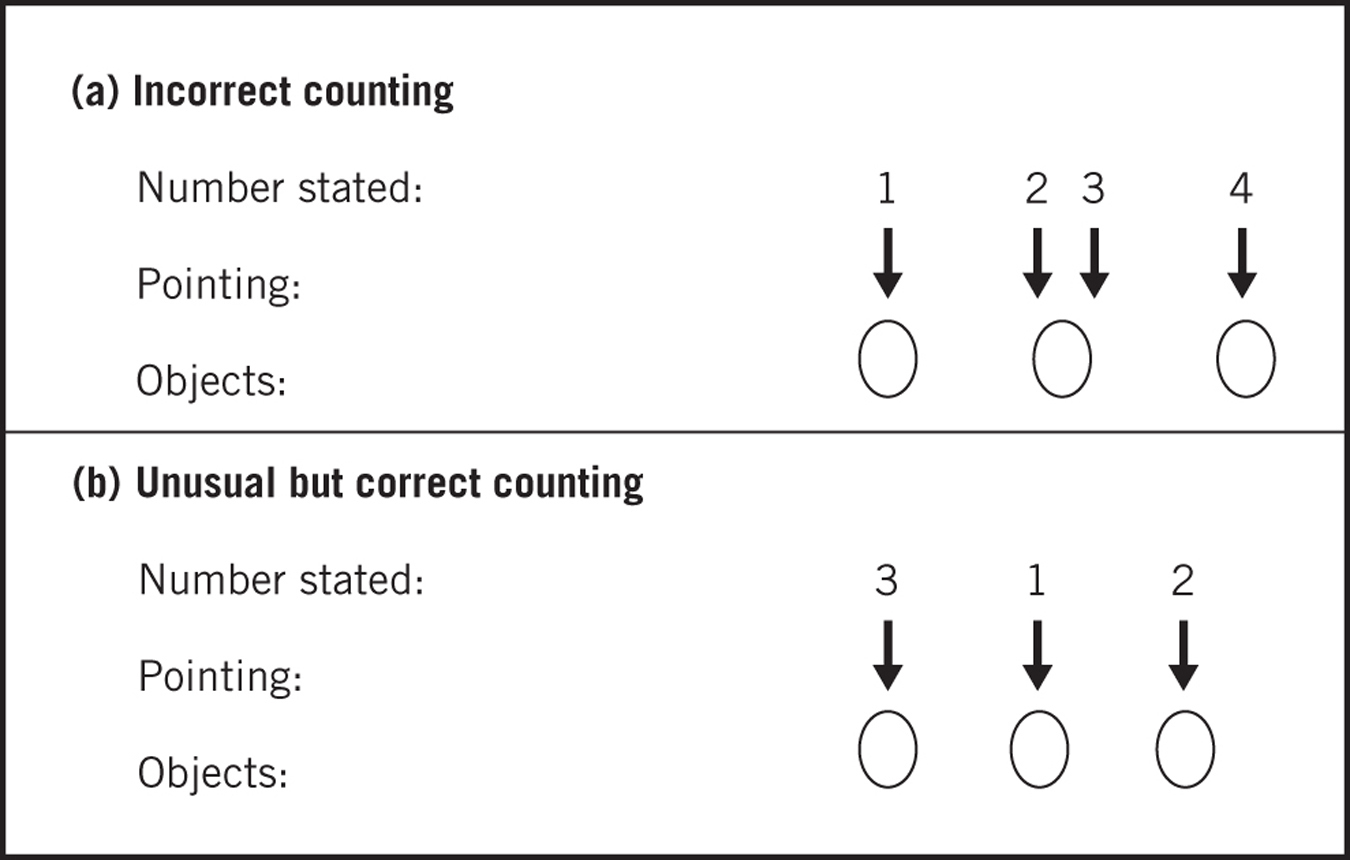
Much of the evidence that preschoolers understand these principles comes from their judgments when observing two types of counting procedures: incorrect counts and unusual but correct counts. When 4- or 5-year-olds see a puppet counting in a way that violates the one–one correspondence principle—for example, by labeling a single object with two number words (Figure 7.8a)—they consistently say that the counting is incorrect (Frye et al., 1989; R. Gelman, Meck, & Merkin, 1986). In contrast, when they see the puppet count in ways that are unusual but that do not violate any principle—for example, by starting in the middle of a row but counting all the objects (Figure 7.8b)—they judge the counting to be correct, even though they say that they would not count that way themselves. The preschoolers’ realization that procedures that they themselves would not use are nonetheless correct shows that they understand the principles that distinguish correct from incorrect counting.
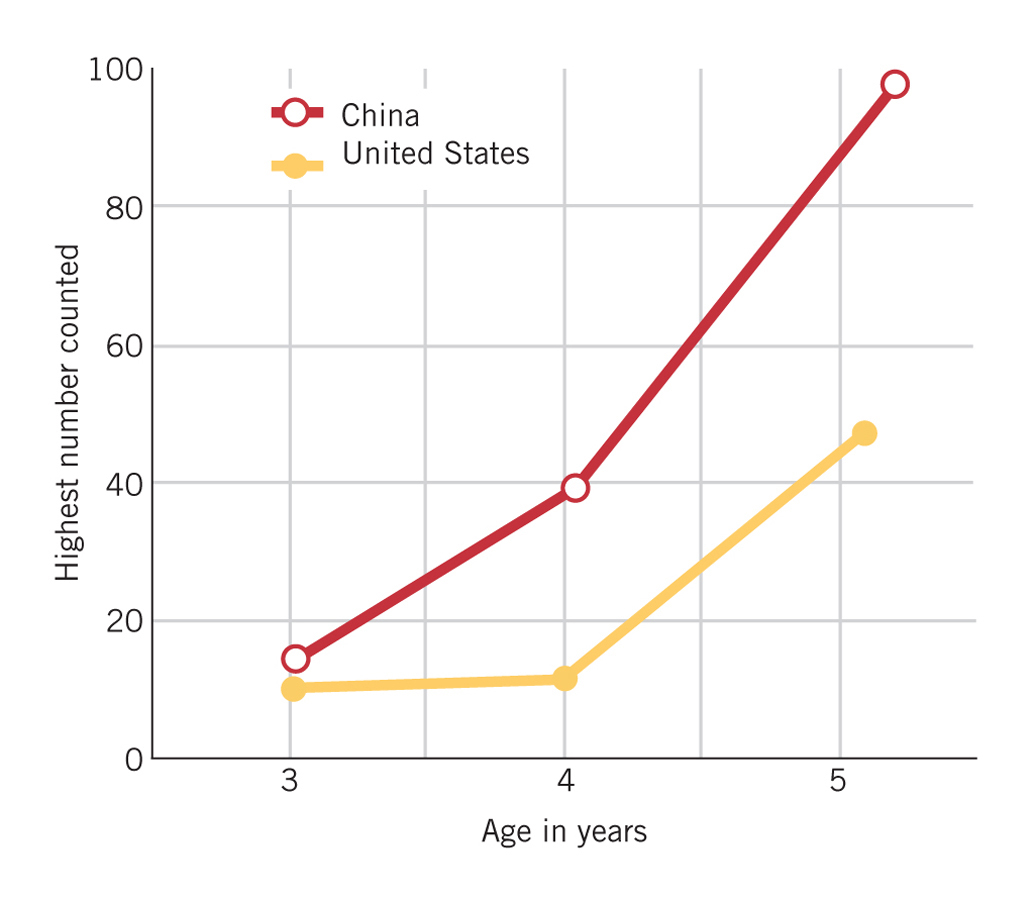
Although children all over the world learn number words, the rate at which they do so is affected by the specifics of the number system used in their culture. As Kevin Miller and his colleagues (1995) note, for example, most 5-year-olds in China can count to 100 or more, whereas most 5-year-olds in the United States cannot count nearly as high. Part of the reason for this difference in counting proficiency seems to be the greater regularity of the Chinese number system, particularly with respect to numbers in the teens. In both Chinese and English, the words for numbers greater than 20 follow a regular rule: decade name first, digit name second (e.g., twenty-one, twenty-two, and so forth). In Chinese, the words for numbers between 11 and 19 follow the same rule (equivalent to ten-one, ten-two, and so on). In English, however, no simple rule indicates the numbers between 11 and 19; each term has to be learned separately.
292
Figure 7.9 charts the apparent impact of this cultural difference in number systems. Three-year-olds in the United States and China are comparable in their ability to recite the numbers 1 through 10, which do not follow any obvious rule either in the English or the Chinese language. However, Chinese 4-year-olds quickly learn the numbers in the teens and succeeding decades, whereas their U.S. peers experience prolonged difficulty with the teens. The difference in language is not the only reason that the counting skill of U.S. children lags behind that of children in China. Chinese culture places a much greater emphasis on mathematical skill than U.S. culture does, and Chinese preschoolers are consequently more advanced than their U.S. peers in numerical skills generally, including arithmetic and number-line estimation (Siegler & Mu, 2008). Still, the greater simplicity of the Chinese system for naming numbers in the teens seems to be one contributor to Chinese children’s greater counting proficiency.
Relations Among Understanding of Space, Time, and Number
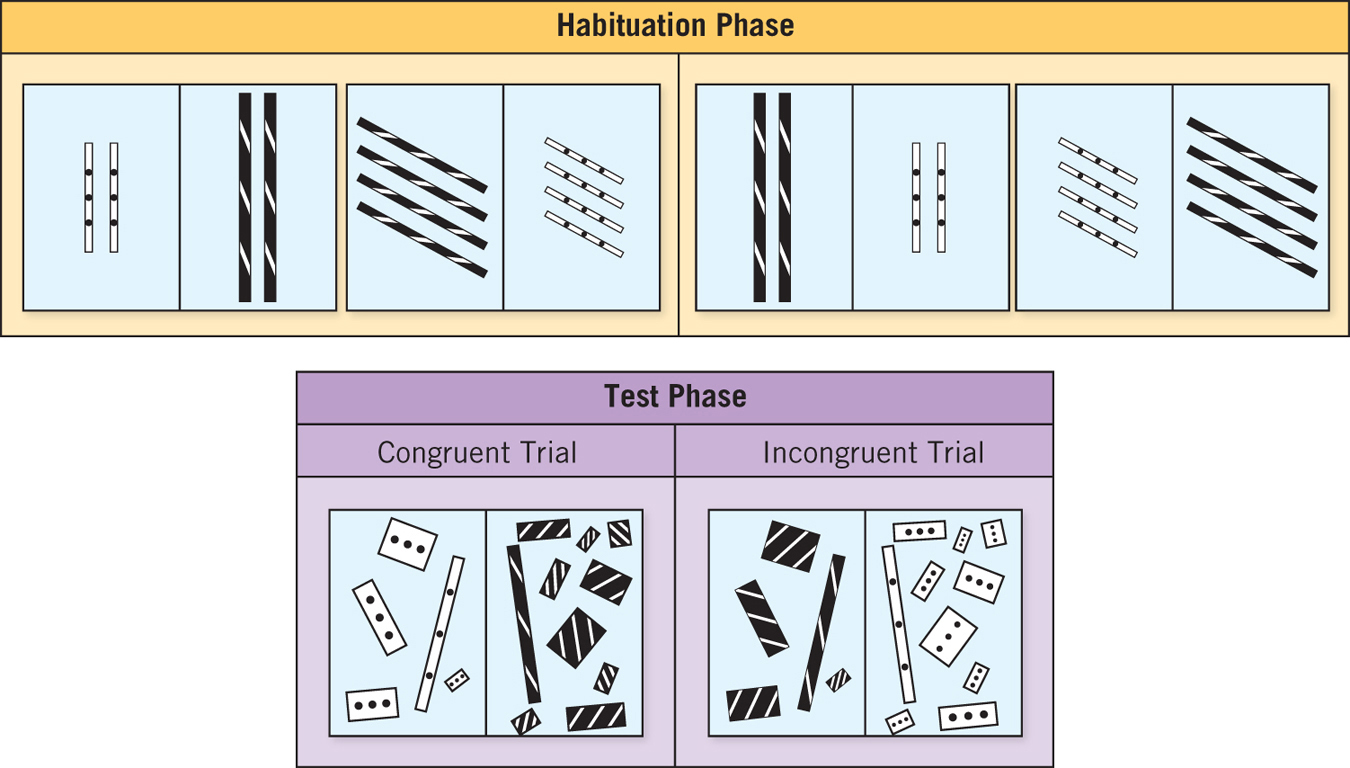
Piaget (1952) hypothesized that infants possess only a general, undifferentiated concept of magnitude, and lack specific concepts of space, number, and time. That is, he thought that infants have a concept of “bigness” but do not distinguish among larger size, greater number, or longer time. Subsequent research has shown that infants actually do distinguish among size, number, and time. For example, after habituating to different displays with the same number of objects, infants dishabituate when the number of objects changes, even though the space occupied by the new objects and the time for which they are displayed is the same as previously (F. Xu & Arriaga, 2007; F. Xu & Spelke, 2000).
However, the fact that infants possess specific concepts of space, time, and number does not mean that they lack the type of undifferentiated magnitude concept that Piaget suggested. Indeed, Lourenco and Longo (2010) found that 9-month-olds have a general sense of magnitude that extends to space, number, and time. The infants in their study were initially habituated to the type of display shown at the top of Figure 7.10, in which a particular decoration (e.g., black with white stripes) consistently accompanied the larger of two stimuli on one of the three dimensions (e.g., size). Then the infants were presented displays in which the link between decoration and relative magnitude on a different dimension either was maintained or changed. For example, infants who had habituated to a link between black with white stripes and larger size might now see that decoration accompanying either the more numerous set (bottom left in Figure 7.10) or the less numerous one (bottom right in Figure 7.10). Lourenco and Longo found that the infants dishabituated when the decoration that had accompanied the larger stimulus now accompanied the one that was smaller on another dimension, but not when it continued to accompany the larger one. Similar results were obtained regardless of whether the habituated dimension was size, number, or time, and regardless of whether the dimension that subsequently varied was size, number, or time.
293
Other studies report the same conclusion (de Hevia & Spelke, 2010; Srinivasan & Carey, 2010). For instance, the ratios required for infants of a given age to discriminate between two stimuli are similar regardless of whether the discrimination involves time, space, or number (Brannon, Lutz, & Cordes, 2006; Brannon, Suanda, & Libertus, 2007). Moreover, overlapping brain areas in the intraparietal sulcus are involved in representing all three dimensions (Dehaene & Brannon, 2011). Thus, infants appear to have both the general, undifferentiated concept of magnitude that Piaget hypothesized they have and also the more specific concepts of time, space, and number that he hypothesized they lack.
review:
A basic understanding of causality emerges extremely early in development. Infants in their first year distinguish between physical causes, in which actions are produced by direct contact, and psychological causes, in which actions are produced by desires and beliefs. During the preschool and elementary school periods, children become increasingly adept at inferring causal relations, even when the relations are more complex and require deeper understanding of causes, effects, and the mechanisms that link them. However, belief in magic and the supernatural coexist with this growing understanding of causal mechanisms, especially in the preschool years.
294
People, like other animals, are biologically prepared to code specific types of spatial information in specific parts of the brain. From the first year, children represent spatial locations relative both to their own bodies and to other features of the environment, such as landmarks. Self-produced movement seems crucial in the further development of spatial representations.
A rudimentary sense of time also is present extremely early: by age 3 months if not earlier, infants possess a sense of the order in which events happened. However, an accurate sense of duration doesn’t develop until 3 to 5 years of age, and learning to reason logically about time takes even longer.
A basic recognition of differences between sets of one, two, and three objects or actions is present in the first year, as is ability to discriminate between larger sets whose numbers differ by substantial ratios. However, not until age 3 or 4 years do children show precise understanding with sets larger than three. During the preschool period, children also learn the principles underlying counting, such as that each object must be counted once and only once. By age 5 years, most also learn the number system of their language. Learning of counting is influenced by the regularity of the number system in the child’s language as well as by the culture’s emphasis on mathematics.
In addition to specific representations of space, time, and number, infants also possess a general representation of magnitude that extends across all three dimensions. If a decoration is associated with the larger value on one of the three dimensions, infants expect the decoration to accompany the larger value on the other dimensions as well. The overlap in the brain areas in which the three dimensions are represented probably contributes to this general representation of magnitude.